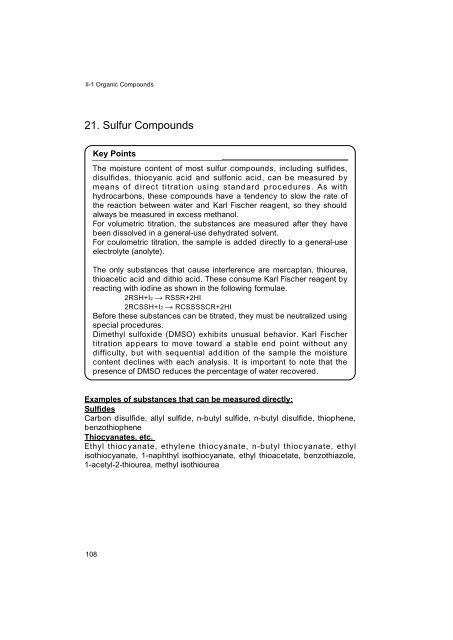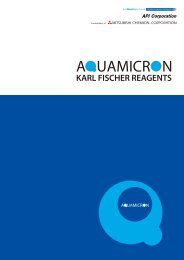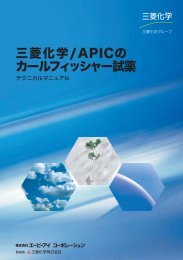Development of Karl Fischer Reagents
Development of Karl Fischer Reagents
Development of Karl Fischer Reagents
Create successful ePaper yourself
Turn your PDF publications into a flip-book with our unique Google optimized e-Paper software.
II-1 Organic Compounds<br />
21. Sulfur Compounds<br />
The moisture content <strong>of</strong> most sulfur compounds, including sulfides,<br />
disulfides, thiocyanic acid and sulfonic acid, can be measured by<br />
means <strong>of</strong> direct titration using standard procedures. As with<br />
hydrocarbons, these compounds have a tendency to slow the rate <strong>of</strong><br />
the reaction between water and <strong>Karl</strong> <strong>Fischer</strong> reagent, so they should<br />
always be measured in excess methanol.<br />
For volumetric titration, the substances are measured after they have<br />
been dissolved in a general-use dehydrated solvent.<br />
For coulometric titration, the sample is added directly to a general-use<br />
electrolyte (anolyte).<br />
The only substances that cause interference are mercaptan, thiourea,<br />
thioacetic acid and dithio acid. These consume <strong>Karl</strong> <strong>Fischer</strong> reagent by<br />
reacting with iodine as shown in the following formulae.<br />
2RSH+I2 � RSSR+2HI<br />
2RCSSH+I2 � RCSSSSCR+2HI<br />
Before these substances can be titrated, they must be neutralized using<br />
special procedures.<br />
Dimethyl sulfoxide (DMSO) exhibits unusual behavior. <strong>Karl</strong> <strong>Fischer</strong><br />
titration appears to move toward a stable end point without any<br />
difficulty, but with sequential addition <strong>of</strong> the sample the moisture<br />
content declines with each analysis. It is important to note that the<br />
presence <strong>of</strong> DMSO reduces the percentage <strong>of</strong> water recovered.<br />
108<br />
Key Points<br />
Examples <strong>of</strong> substances that can be measured directly:<br />
Sulfides<br />
Carbon disulfide, allyl sulfide, n-butyl sulfide, n-butyl disulfide, thiophene,<br />
benzothiophene<br />
Thiocyanates, etc.<br />
Ethyl thiocyanate, ethylene thiocyanate, n-butyl thiocyanate, ethyl<br />
isothiocyanate, 1-naphthyl isothiocyanate, ethyl thioacetate, benzothiazole,<br />
1-acetyl-2-thiourea, methyl isothiourea




